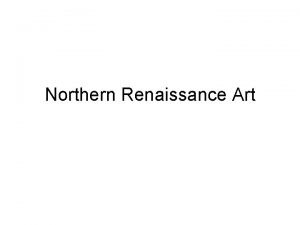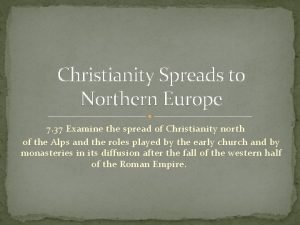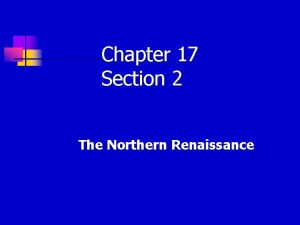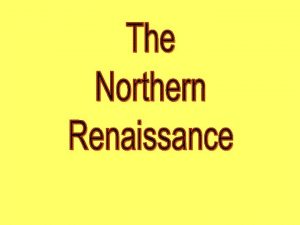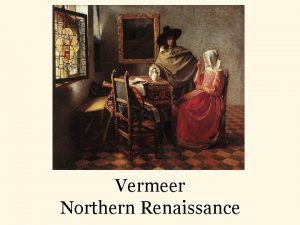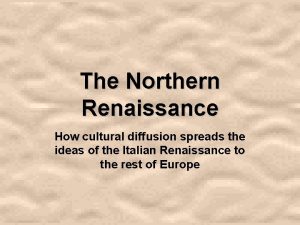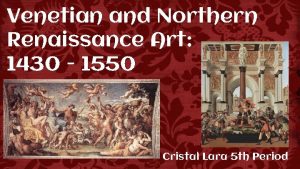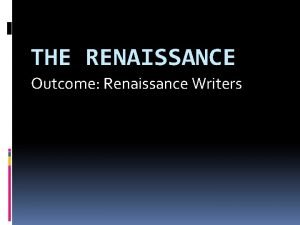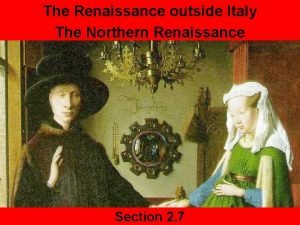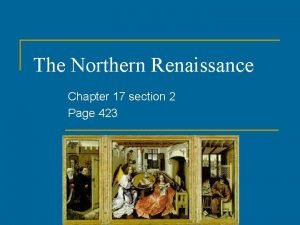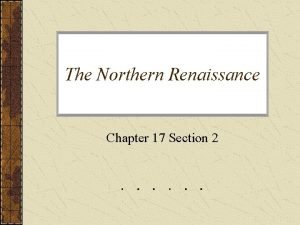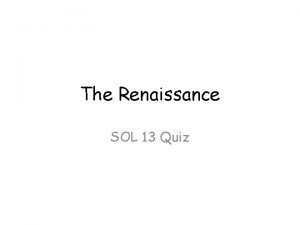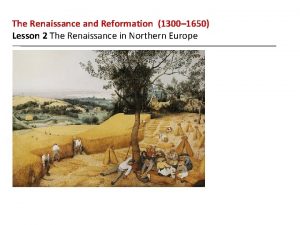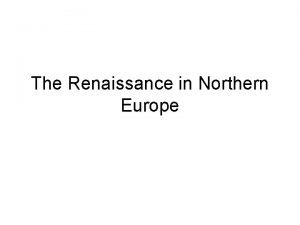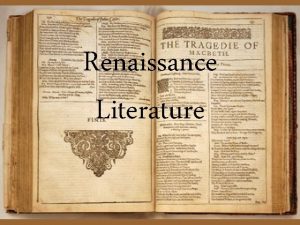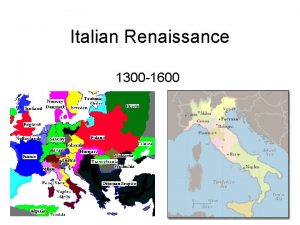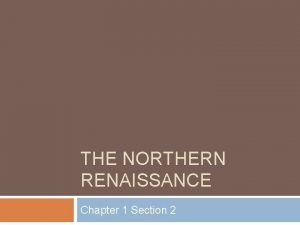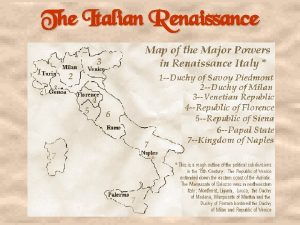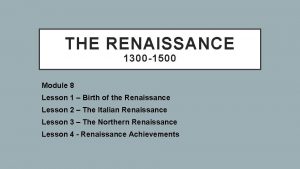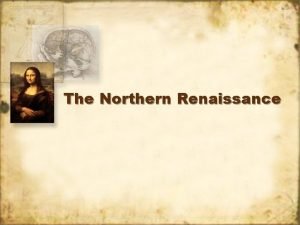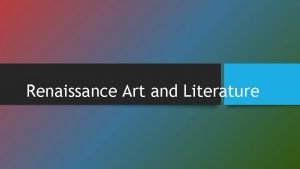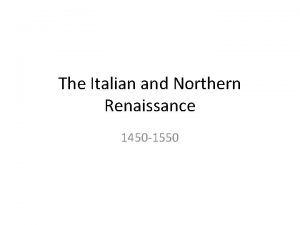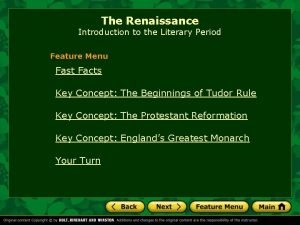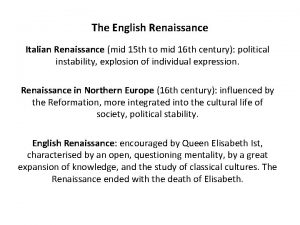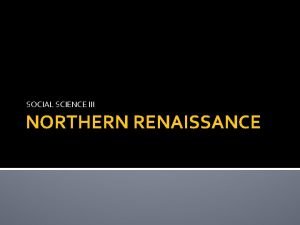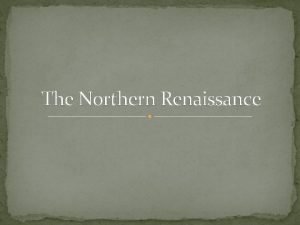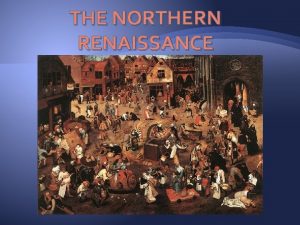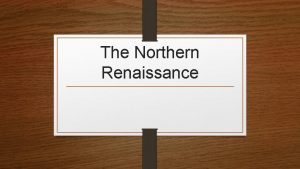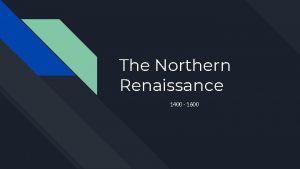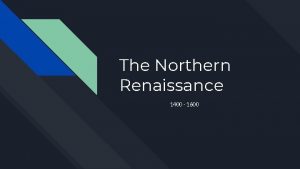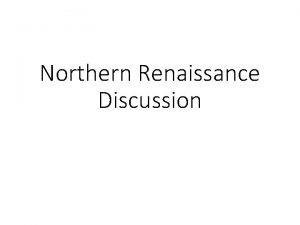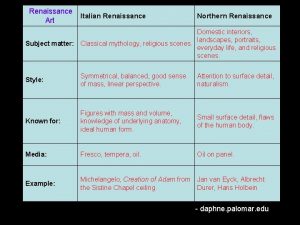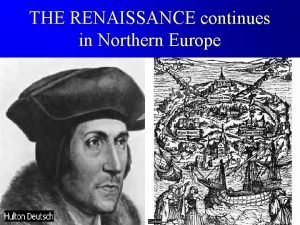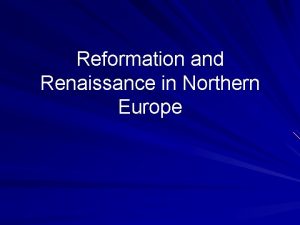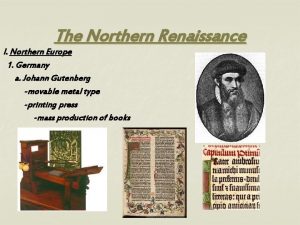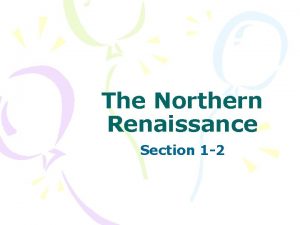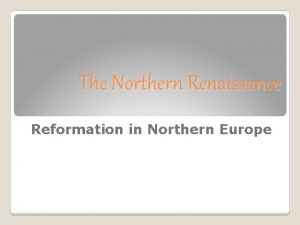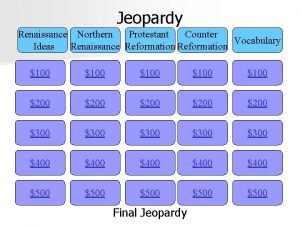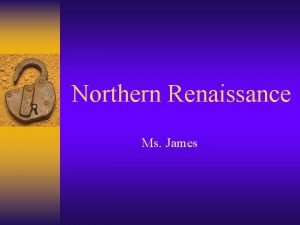The Northern Renaissance Where was the Northern Renaissance



























- Slides: 27

The Northern Renaissance

Where was the Northern Renaissance? • • England France Germany Flanders (Netherlands/Belgium)


The Northern Renaissance: 1450 • • Bubonic Plague ended and the population was recovering Hundred Year’s War between France and England was ending. New ideas from Italy spread to Northern Europe and were quickly adopted. Educated people in Northern Europe became interested in classical learning • Difference from Italy- were more likely to combine this with interest in religious ideas.

Factors leading to Renaissance in Northern Europe • Population recovers from plague • Hundred Years’ War ends in 1453 • Patrons • Cities grow rapidly • England France unify under strong monarchs who are art patrons • Students and visitors from Italy bring back ideas • Artists and writers move to northern Europe fleeing war in Italy (1494)

Art in northern Renaissance vs. Italian Renaissance • Northern Renaissance artists were interested in realism • Major artists appeared in parts of Germany, France, Belgium and the Netherlands. • Durer, Holbein, van Eyck and Bruegel • Use of oil-based paints becomes popular. • Religious subjects and realistic landscapes often painted. • Scenes of peasant life also become popular.



Bruegel Peasant Wedding The bride sits under the paper crown Notice the furnishings Groom may be the one sitting across from the bride Relaxed, humorous, and focused on ordinary people

• What can be learned about people’s daily lives from examining the painting Peasant Wedding? • Where ordinary people lived, what they ate, how they dressed, how they celebrated

Hans Holbein the Younger • German painter who moved to London and painted for Henry VIII

Hans Holbein the Younger • Portrait of Anne of Cleves • Henry VIII criticized the portrait as having been too flattering

Question: • What factors might have influenced the trend toward a more realistic style of art? • Artists could travel and thereby learn better techniques; oil paints made more realistic, subtle paintings possible

Northern Writers • Writers combined humanism with deep Christian faith. • Wanted reforms in the Church and society to try to make people more just and devoted to God. • Desiderius Erasmus • Christian humanist • Wrote The Praise of the Folly- poked fun at flaws in real people. • Thought people should read the Bible for themselves

Writers continued • Thomas More • Christian humanist • Wrote Utopia (means “no place”)- no war, corruption, greed, little use of money) • Based off of Plato’s The Republic • Beheaded by King Henry VIII (one of his best friends!)

Shakespeare • Many times viewed as the greatest playwright of all time. – Do you agree? • Plays examine deep human flaws- Can you think of any? • Drew on Greek and Roman classics • What works from Shakespeare do you know?

Phrases from Shakespeare’s plays • Today, almost 400 years after his death, the language of Shakespeare is all around us. • “at one fell swoop” • “foul play” • “good riddance” • “high time” • “lie low” • “Mum’s the word” • “vanish into thin air” • “neither here nor there” • “the game is up”

Globe Theater Performances were often wild affairs. If the audiences did not like the play, they booed loudly, pelted the stage with garbage (oranges, nuts, apples, and gingerbread) and sometimes attacked the actors. A full house was about 3, 000 paying customers.

Life in the Renaissance • 1500 s- 75% of Europeans lived in rural areas. • London 200, 000 people in 1600 • Cost of living • If a pound was worth $400 in today’s currency, then a shilling was worth $20 and a penny was worth about $1. 66. • This means that a skilled worker earned $5, 200 per year. • A merchant would earn about $40, 000. • The cost of a theater performance was 1 shilling ($20) for the lords’ room, 6 pence ($10) for the gentlemen’s rooms, 2 pence ($3. 30) for the galleries, and 1 penny ($1. 66) for the pit. • One in every 10 people in London went to theater at least once a week.

Food? Yuuuuummmmm A typical meal for wealthy Londoners › Fish, several kinds of meat, bread, and a variety of vegetables, served on silver or pewter tableware. The diet of the poor was simpler. › Rarely ate fish, meat, or cheese. Usually their meals consisted of a pottage-a kind of soup-of vegetables. They ate their meals from a hollowed out slab of bread or wood.

Printing Spreads Renaissance Ideas • Chinese Invention • Around 1045 Bi Sheng of China invents movable type

Gutenberg Improves the Printing Press • Around 1440 Johann Gutenberg of Germany develops printing press • Printing press allows for quick cheap book production • First book printed with movable type, Gutenberg Bible (1455)

Book Production • It took 5 months to copy a single book by hand • One man and a printing press could produce 500 books in the same amount of time.

Printing Press How did the invention of the printing press help spread learning and Renaissance ideas? Book were cheaper (more could buy them) News quicker Rise of literacy Published accounts of maps and charts lead to more discoveries Political structures and religious practices are questioned

Printing Press

The Legacy of the Renaissance Art influenced by classical Greece and Rome Realistic portrayals of individuals and nature Art is both secular and religious Writers use vernacular Art praises individual achievements

What similarities and differences? How did the northern Renaissance differ from the Italian Renaissance? Stronger interest in realistic art; more of an emphasis on changing society In what ways did Renaissance art connect to the past? Copied Greek and Roman styles, created religious works In what ways did it break with the past? Increase in secular art, more realistic style, use of vernacular, emphasis on the individual
 Italian vs northern renaissance
Italian vs northern renaissance Italian renaissance vs northern renaissance venn diagram
Italian renaissance vs northern renaissance venn diagram What was the first full-sized book gutenberg printed?
What was the first full-sized book gutenberg printed? Northern renaissance art characteristics
Northern renaissance art characteristics Northern renaissance portraits
Northern renaissance portraits Characteristics of the northern renaissance
Characteristics of the northern renaissance What does humanism mean in the renaissance
What does humanism mean in the renaissance Venetian and northern renaissance (1430–1550)
Venetian and northern renaissance (1430–1550) Writers from the renaissance
Writers from the renaissance Northern renaissance portraits
Northern renaissance portraits The northern renaissance chapter 17 section 2
The northern renaissance chapter 17 section 2 Northern renaissance literature
Northern renaissance literature What movement had the greatest influence on the renaissance
What movement had the greatest influence on the renaissance The renaissance in europe lesson 2
The renaissance in europe lesson 2 How did the renaissance develop in northern europe?
How did the renaissance develop in northern europe? Northern renaissance literature
Northern renaissance literature Northern renaissance portraits
Northern renaissance portraits The northern renaissance began in the cities of
The northern renaissance began in the cities of Northern renaissance art characteristics
Northern renaissance art characteristics Italian renaissance location
Italian renaissance location Lesson 1 the renaissance 1485
Lesson 1 the renaissance 1485 Italian and northern renaissance similarities
Italian and northern renaissance similarities Northern renaissance literature
Northern renaissance literature Italian and northern renaissance
Italian and northern renaissance The renaissance introduction to the renaissance answer key
The renaissance introduction to the renaissance answer key The renaissance outcome the renaissance in italy
The renaissance outcome the renaissance in italy Italian renaissance vs english renaissance
Italian renaissance vs english renaissance The renaissance outcome renaissance painters/sculptors
The renaissance outcome renaissance painters/sculptors
